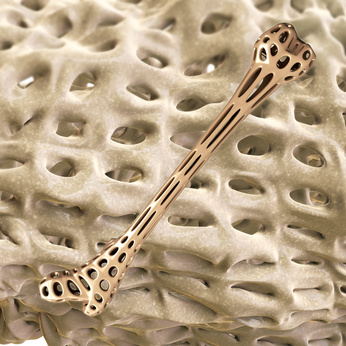Osteoporosis
Definition by WHO
„Osteoporosis is a systemic sceletal disease being characterized by a low bone mass and structural changes of the bone tissue resulting as a consequence in an increased bone fragility and fracture endangering. Quantity of the original bone mass, extent and duration of the bone mass loss determine the probability for osteoporosis to occur.”
We have to distinguish it from osteomalacia, which leads to demineralisation and softening of the bones. The mineralization of the bone is disturbed while the basic bone substance remains undisturbed. In children this clinical picture is called rickets.
We distinguish primary and secondary forms of osteoporosis
Primary: postmenopausal/-climacteric (female) and senile (male)
Secondary: e.g. by corticosteroids, hyperthyreosis, immobilisation, diabetes, rheumatic diseases, nutritional lack of Vtamine D and Calcium, alcohol and nicotine abuse
In the case of postmenopausal osteoporosis, cooperation with the patient’s gynecologist is important so that the latter can clarify hormonal imbalances (including estrogen levels) and treat them promptly if necessary.
Diagnosis
The diagnosis is made in our practice by taking the patient’s medical history (previous illnesses), the clinical-manual examination, the performance of targeted laboratory diagnostics (including bone remodeling markers) and imaging procedures such as x-rays, CT, MRT and DXA bone density measurement.
The repeated determination of bone remodeling markers and the performance of DXA measurements subsequently form a basis for the assessment of the effectiveness of the therapeutic procedures used, but also help to avoid side effects.
Therapeutic methods
Our therapeutic goals are both the preservation of existing bone substance and the reconstruction of new bone substance. This should make the bone skeleton more stable under stress and reduce the risk of bone fracture. Depending on the individual diagnosis, the appropriate therapeutic procedures are carried out sequentially (in sections with breaks or discontinuation) or continuously as required.
Each procedure must include a strategy for dynamic long-term therapy. A change in the chosen form of therapy can and must be possible at any time.
Different stages of life also require different treatment (early postmenopausal, e.g. through the use of oestrogen preparations, in older age rather kidney-compatible medication with administration in the form of an injection or infusion).
In some secondary forms of osteoporosis, such as primary hyperparathyroidism or osteoporosis caused by prolonged cortisone administration (cortisone stop), a cure is even possible.
As prophylaxis and basic therapy, the administration of Vit D3 in combination with calcium (e.g. 1000 mg calcium and 1000 i.U. Vit D3 per day) is generally accepted today.
Special drug therapies such as the prescription of Denosumab (monoclonal antibodies), bisphosphonates (bone resorption inhibitors) or SERM (selective oestrogen receptor modulators) require precise planning and consistent implementation in order to achieve the desired therapeutic success.
Individually adapted drug therapy and fall prophylaxis (training, protectors) are important prerequisites for older patients with concomitant diseases to ensure quality of life with independent mobility and vitality, but also to reduce the risk of fracture or bone fracture.
Fractures (bone fractures) increase not only the morbidity and mortality but also the duration and costs of treatment due to the painful restriction of movement resulting from them.
In fracture situations where the fracture is stable under load, e.g. a sintered fracture of the thoracic or lumbar spine, the use of a 3-point support corset is often sufficient, in addition to an adapted administration of painkillers, to provide the medically necessary stabilization and effective pain relief.
In fracture situations with unstable loading, such as a femoral neck fracture, surgical treatment with a dynamic hip screw or endoprosthesis is medically necessary.
The early mobilisation that is then possible saves the patient concerned from certain death as a result of pneumonia (pneumonia caused by bed-ridden patients).
Kypho- or vertebroplasty for correction of the shape and stabilization of vertebral body fractures
are performed as in-patient treatment in special spine clinics.
Overall, there are many diagnostic and therapeutic options available today for the early detection and treatment of osteoporosis as a widespread disease.
An optimized diet and regular exercise from youth to old age are a useful contribution to prevention.



